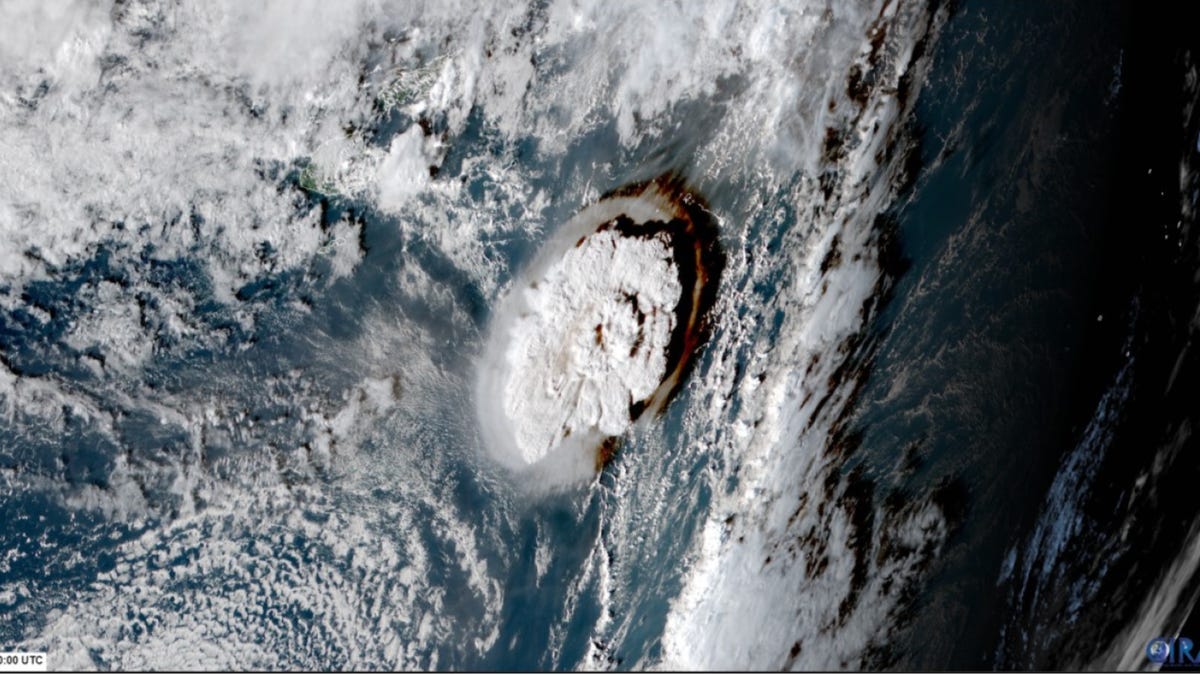Underwater Volcano Spit Shock Waves Into Space That Lapped Earth Several Times
"My gut feeling is that there is more to come from this eruption," says one researcher about January's Tonga volcanic eruption.

On Jan. 15, at about 4:20 a.m. local time, a significant tsunami was observed across the Pacific basin resulting from the undersea volcanic eruption in the Tonga Islands region.
At the beginning of this year, from deep within the South Pacific Ocean, an underwater volcano erupted. But this wasn't just any old eruption. It was a submarine explosion that spit out a blast so utterly powerful it unleashed sonic booms. It forced tsunami waves around the world. It plumed ash into the atmosphere and rippled shock waves with enough vigor to reach across Pacific basin waters and ascend until they touched the edge of space.
The Hunga Tonga-Hunga Ha'apai eruption was monstrous. It's often referred to as one of the most explosive volcanic events in recorded history -- some experts even classify those shock waves as among the largest space-borne disturbances of the modern era.
Here's a shattering satellite video of the ordeal.
The GOES-17 satellite captured images of an umbrella cloud generated by the underwater eruption of the Hunga Tonga-Hunga Ha'apai volcano on Jan. 15, 2022. Crescent-shaped bow shock waves and numerous lighting strikes are also visible.
From our eyes, it's an extreme, quite terrifying, act of nature. But from the lens of science, it's a serendipitous occurrence that can help answer some of the most interesting questions about Earth's atmosphere. This is why, since the volcanic drama settled down, researchers have been meticulously tracking every bit of data recorded about the eruption.
And on Thursday in the journal Nature, one such team announced a new development.
The shock waves that reached space, also known as atmospheric waves, were the fastest-ever observed within our planet's gaseous shell, the new study found. These ripples reached speeds of 720 miles per hour while lapping Earth at least six times.
"This was a genuinely huge explosion and truly unique in terms of what's been observed by science to date. We've never seen atmospheric waves going round the whole world before, or at this speed -- they were traveling very close to the theoretical limit," Corwin Wright of the Center for Space, Atmospheric and Oceanic Science at the University of Bath and the paper's lead author, said in a statement.
Plus, to further bolster the mightiness of Tonga's volcanic detonation, the new study's authors combined extensive satellite data with ground-based observations to offer concrete proof that this event was indeed an absolute mammoth. "The data we've been able to gather on it will enhance our understanding of our atmosphere and will help us improve our weather and climate models," Wright said.
Collecting data from an explosion
Already, scientists around the world who are scrutinizing the eruption have found pretty awesome things.
In May, for instance, a crew that sailed over the volcanic caldera -- the depression that forms post-volcanic eruption -- saw the dent was jaw-droppingly enormous. "It was an amazing finding," one team member told Nature.
In the same month, another group reported that extreme winds emanating from the volcano had affected electric currents in the ionosphere, forcing east-flowing streams to flip direction dramatically and surge to five times that of normal peak power. "This is something we've only previously seen with strong geomagnetic storms, which are a form of weather in space caused by particles and radiation from the sun," one of this study's co-authors told NASA.
Some experts believe the Tonga saga could eventually aid in studies about space weather, which is a phenomenon that directly affects you and me.
When electrons shooting from the sun -- the result of huge coronal mass ejections -- get caught in Earth's atmosphere, they don't only produce wonderful auroras. They also pose threats to terrestrial power, confuse GPS satellites and endanger the lives of anyone on the ISS. Thus, "understanding space weather holistically will ultimately help us mitigate its effects on society," Jim Spann, space weather lead for NASA's Heliophysics Division at NASA, said in a statement.
A diagram indicating the Tonga volcano's positioning under different layers of Earth's atmosphere.
Further into the future, though, Scott Osprey, a co-author of the new study and researcher at the Department of Physics at the University of Oxford, said "my gut feeling is that there is more to come from this eruption." What we know so far could very well have only scratched the surface of the volcano's legacy. For example, in the team's latest update on the eruption, they show how the display of waves that reverberated around the world were driven by huge amounts of vaporized seawater stemming from the explosion itself.
"As the exceptional amount of water vapor spreads throughout the stratosphere," Osprey said, "eyes will turn to the Antarctic ozone hole and just how severe it will be in the spring."
It's been years since a relative needlepoint in the Antarctic ozone layer became larger than the entire continent of Antarctica. The puncture was primarily driven by human activity like releasing aerosols into the atmosphere, which is why, disturbed by this outcome, scientists urged governments to take action and mitigate the use of certain harmful human-made chemicals.
Now, the ozone hole is on a slow, but sure, path toward healing. But, hopefully, despite it being an "amazing natural experiment," per Wright, Hunga Tonga's drastic detonation won't bring that vital ozone-healing process to a halt.

